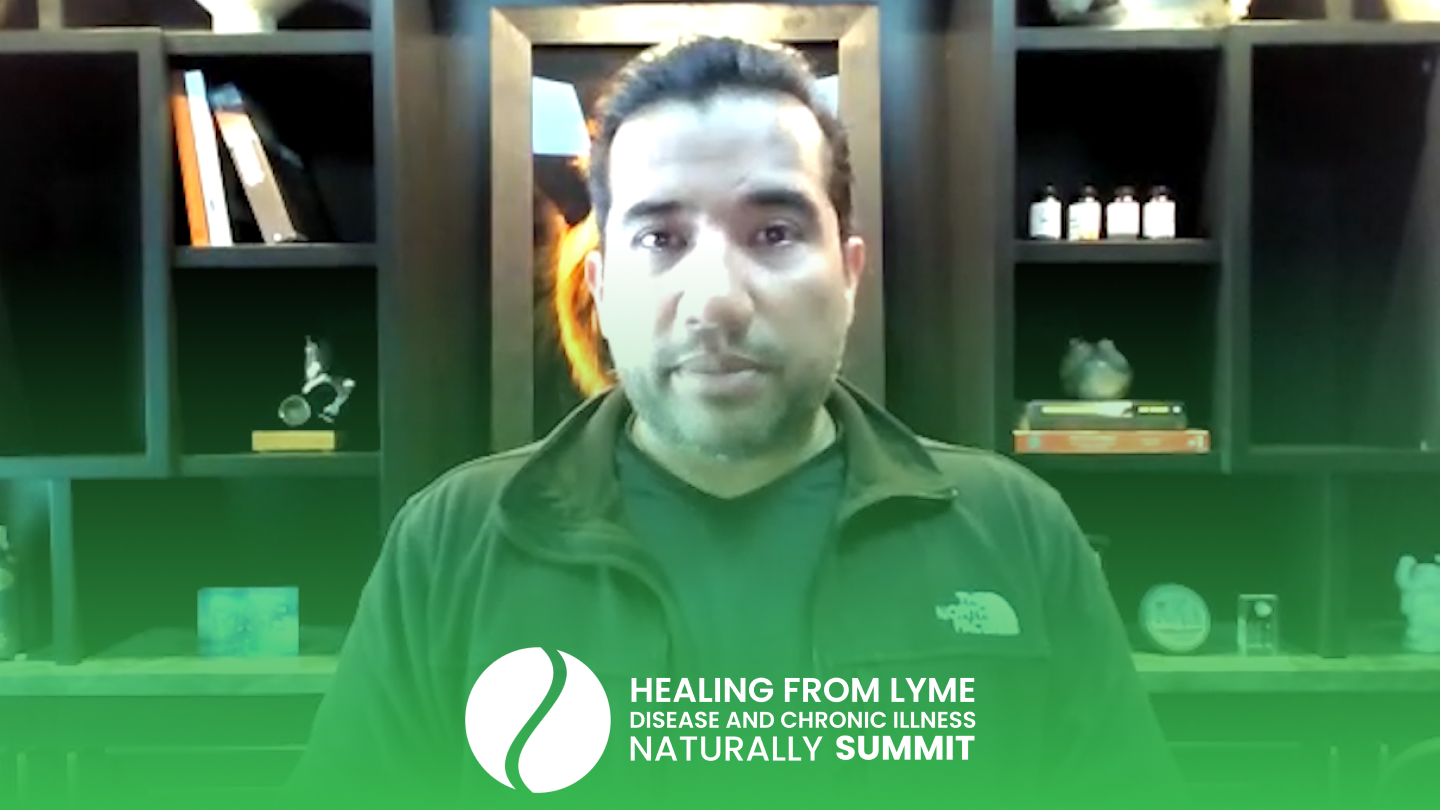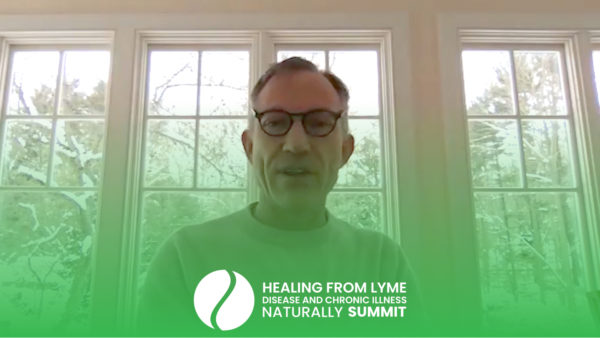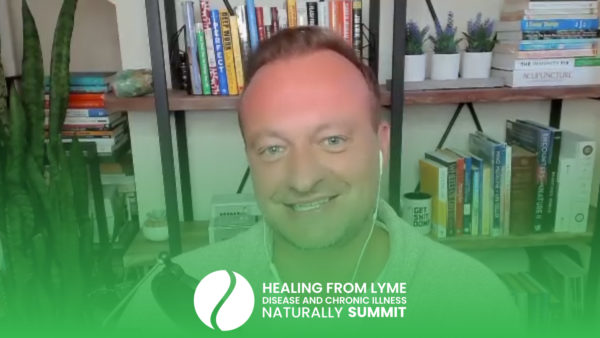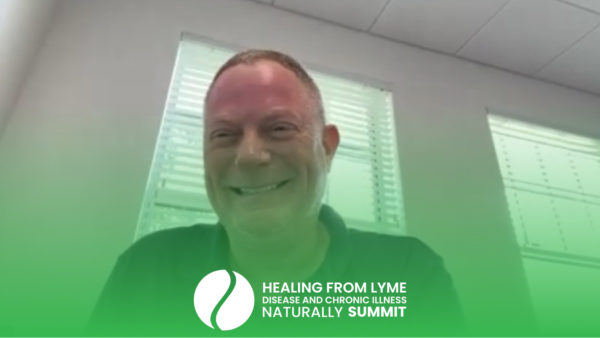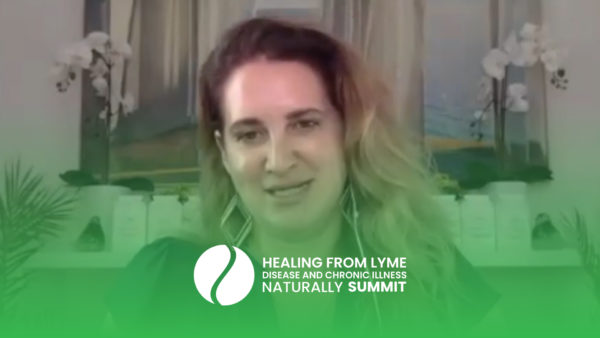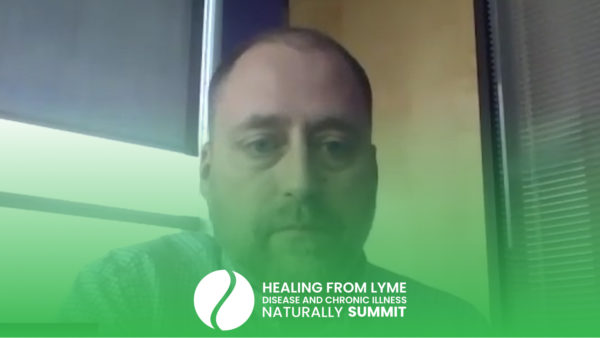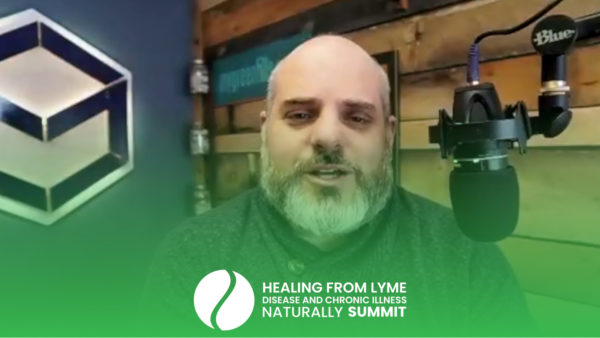Join the discussion below
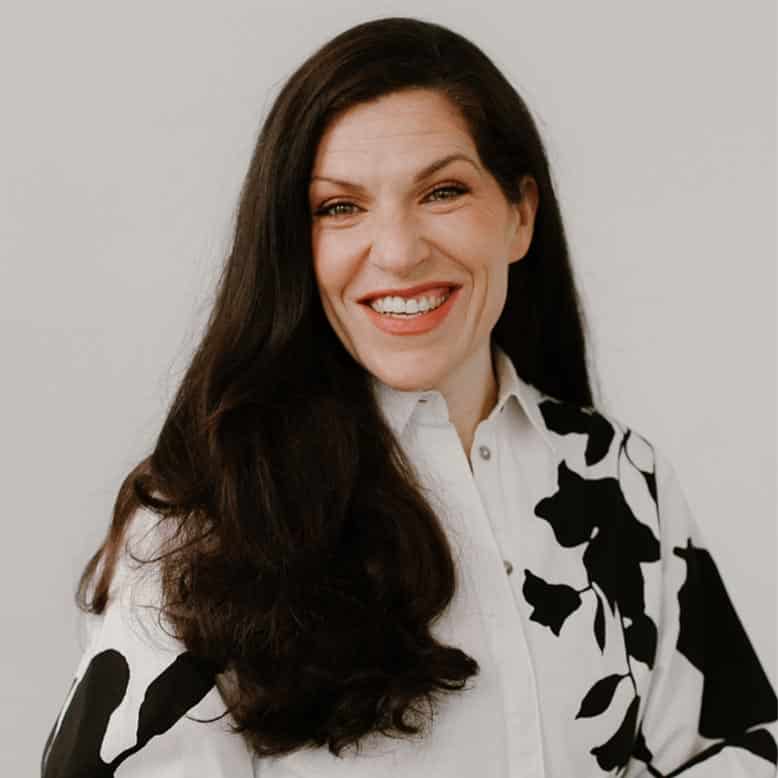
Dr. Christine Schaffner is a board-certified Naturopathic Doctor who has helped thousands of people recover from chronic or complex illnesses. Through online summits, her Spectrum of Health podcast, network of Immanence Health clinics, and renowned online programs, Dr. Schaffner goes beyond biological medicine, pulling from all systems of medicine and... Read More

Kiran Krishnan is a Research Microbiologist and has been involved in the dietary supplement and nutrition market for the past 18 years. He comes from a University research background having spent several years with hands-on R&D in the fields of molecular medicine and microbiology at the University of Iowa. Kiran... Read More
- The role of the Microbiome in chronic illness and chronic infections.
Related Topics
Chronic IllnessChristine Schaffner, N.D.
Welcome everyone to the Healing from Lyme and Chronic Illness Summit. I’m here with our dear colleague and friend, Kiran Krishnan. And we’re gonna be talking about the role of the microbiome in chronic illness and chronic infections. Welcome, Kiran, it’s always so fun to interview you.
Kiran Krishan
Hi, Christine, thank you so much for having me, so great to be here.
Christine Schaffner, N.D.
Absolutely, well, as the title of the talk states, I think that there’s a huge opportunity, especially with your expertise and your perspective, and now doing this work with this community for so long to really, I’m always when I’m sitting at my desk and interviewing patients I’m always trying to think, okay, why is this person sick and maybe their loved one not, or their other family member, or their friend. And I’m always trying to think through the lens of a bio-regulatory medicine or terrain medicine, what makes all of us unique and different and some of us more vulnerable to these chronic infections or chronic pathogens. And so, let’s just maybe dive in and your perspective of what do we know about the microbiome and its role in making us potentially more vulnerable to chronic illness?
Kiran Krishan
Yeah, absolutely. So, in fact, you can’t think of a better model that predicts chronic illness than looking at microbiome dysbiosis. So that, the pathologies associated with microbiome dysbiosis can explain the origins of almost any chronic illness we can think of. So, and especially when you look at more specifically the resulting endotoxemia to dysbiosis and that’s flooding in of LPS on a regular basis. So if you look at metabolic endotoxemia, and then you look at disease pathology, for almost any chronic disease, you see a close-knit tie there in terms of the origins. And metabolic endotoxemia is as a result of a dysbiotic gut. In fact, there was a 2015 publication in “Frontiers of Immunology” that did a meta analysis of whole bunch of papers on this topic.
I think dozens upon dozens of papers and what they concluded after the end of all of that, and these were, I think, seven authors on that study was that leaky gut or intestinal permeability caused by a dysbiotic gut microbiome, and then the resulting inflammatory activation of that leaky gut, was the number one cause of morbidity and mortality worldwide. Number one. And they showed and they walked through all of the pathophysiology of how that dysbiosis and that resulting intestinal permeability drives a huge variety of chronic illnesses. And then which chronic illness you develop based on that foundation will depend on your genetics, your lifestyle, other susceptibilities.
So whether that dysbiosis, intestinal permeability, LPS endotoxemia leads to diabetes, or it leads to reflux, or it leads to anxiety, will depend on other factors, but make no mistake that all of those conditions that are seemingly unrelated because they affect different parts of the body. If you look at autoimmune disease, diabetes, reflux, Alzheimer’s, those affect different parts of the body in very different ways, they all have the same exact root cause. They have the same foundation that allowed those conditions to happen.
And it’s so interesting to look at what allows for infection, what allows for dysfunction, and what allows for chronic dysfunction are all the same. And in fact, infection can drive dysfunction and chronic dysfunction. Dysfunction and chronic dysfunction can drive infection. They’re all related, motivated and provided for by the same root dysfunction, which is intestinal permeability and the chronic inflammation that’s associated with it.
Christine Schaffner, N.D.
And that makes a lot of sense, I’m a naturopath, and so we are hyper-focused on the gut and how so much of our immune system and really our whole ability to assimilate, digest, I mean, it’s just the foundation of health. And so, here we are and I mean I have a caveat, I guess, to the one you were thinking of first, the gut and the gut microbiome, but there are microbiomes throughout the body, as well. And that’s a whole nother rabbit hole and how that interaction with our environment and our immunity, but let’s just stay in the gut for some time here.
And so, we know there are certain signals or certain trends with the patient, like we’re talking really right now to patients with often Lyme and co-infections. And then we’re seeing also healing from chronic illness. So we know these patients. They have Lyme and co-infections, but they have high viral titers. They have often a mycotoxin burden and they don’t clear mycotoxins as well as maybe average person. They might still have a parasitic infection that they caught 10 years ago and never really cleared, there’s this kind of ecosystem disruption as far as looking at all of these pathogens. And so, I guess my first question is from your experiences, knowing this patient population, have you found trends or like signals within the microbiome that you’re like, oh, I understand why this person is a pathogen collector, they’re sick, do you have any ideas around that?
Christine Schaffner, N.D.
Yeah, absolutely. So, and in fact, recent studies on COVID confirms a lot of that as well. So those individuals will almost always have low diversity in the microbiome, in the gut microbiome. And then they will almost always have very low levels of certain keystone species, especially if you kill them bacteria prosthetics eye, Akkermansia to a certain degree, Bifidobacterium adolescentis and Bifidobacterium longum they’ll tend to have low, low levels of those.
They will tend to have chronic high levels of interleukin-6, interleukin-1 beta, and potentially interfere on alpha as well. So that then becomes this characteristic of the type of environment that invites chronic illness and invites chronic infection. They go hand in hand. So, in COVID, as I mentioned earlier, exemplified this, because one of the things we all came to learn in the first, even six months, seven months of the start of the pandemic was that certain people were far more susceptible to a really bad outcome than others. Age was one factor.
But the other factors that were actually even more profound were the presence of diabetes, the presence of heart disease, the presence of hypertension, obesity. So if we look at these co-morbidities or these underlying factors, those individuals were seven to 10 times more likely to die from COVID than individuals of the same age that did not have those conditions. So let’s take diabetes for a moment and look at that. So why is it that, let’s say if you’re a 45-year-old with diabetes or even early stage pre-diabetes, you are almost 10 times more likely to die from COVID than a 45-year-old that does not have diabetes. 10 times, I mean, that’s a massive difference.
Why is that? Is it because of the dysregulation of blood sugar? Does that somehow disrupt immune function? No, not really. The person with diabetes also has low diversity, low Akkermansia, low-feekaylin bacteria, low Bifidobacterium animalis and adolescentis, in particular. And all of those features are core features of having diabetes, having elevated interleukin-6, elevated interleukin-1 beta and elevated interferon gamma. So those things are the same features of having diabetes as it is the features that they found to be the biggest risk factors for developing really long COVID and problematic COVID. So, at the end of the day, it’s not the diabetes that is causing your disruption in your body’s ability to defend against the infection.
It’s the root cause of diabetes, the low diversity, the disruption of the microbiome, the intestinal permeability that allowed you to get diabetes is the same root cause that’s gonna increase your risk for a really bad infection. So that’s where it really made it very clear that it’s this collection of foundational characteristics that lead to all these kinds of illnesses. There was another big study with COVID called the Boston Dublin study. There was a big group of researchers in Boston and a big group of researchers in Dublin, and they were examining patients with COVID and all that in different regions and then sharing and collaborating their data. They were looking for biomarkers that could predict the severity of your COVID response. Whether you’re gonna be hospitalized or what is your risk for mortality from this? They only found two things, that were present and was predictable of your response to COVID. Number one was your level of interleukin-6. And number two was your level of interleukin-10.
And in particular, how higher interleukin-10 was, if the higher it was the more protective it was. And if your interleukin-6 was high, then you were much more susceptible. interleukin-6 is a quintessential inflammatory cytokine, interleukin-10 is an anti-inflammatory cytokine. So the biggest feature in having intestinal permeability, one of the key things in testing for intestinal permeability and the immune response is high interleukin-6 and low interleukin-10, same thing. So the one and only predictor for how badly you’re gonna respond to COVID is the same thing that shows whether or not you have intestinal permeability and dysbiosis. So it’s just, it all is connected in that same way, and really what we’re doing when we’re dysbiotic, and we have intestinal permeability and all that, we’re actually allowing the formation of chronic illness, we’re allowing and inviting in infection, and we’re allowing pathogens to come into an environment that they like. These are the environments that pathogens thrive in.
Christine Schaffner, N.D.
That’s really fascinating. And I hear what you’re saying in this inflammatory, like signal or pattern or a signature in the body is really what’s gonna make us sick and more vulnerable to infections, diagnoses, COVID response, and so really the name of the game is, how do we reduce this pattern so that we’re more resilient to these exposures and these pathogens? And I wanna stay on interleukin-6 for a moment. And so with interleukin-6 is that, and I’m just hearing this in a different way, so curious for my own knowledge, is there a pattern that you see, isn’t just the low diversity or is there also just a key bacteria that prevents that or is there’s something, ’cause it seems to be such an important biomarker, that you really understand to be the driver or driving up interleukin-6?
Kiran Krishan
Yeah, it’s really a collection of conditions. There isn’t a single microbe that’s responsible for driving it. Many microbes can drive interleukin-6 elevation, many pathogens, opportunistic pathogens, virtually every gram negative bacteria, which is more than half the bacteria that exists can drive interleukin-6 levels. But it depends not so much on who’s there to drive it, it depends more on who’s not there, who are supposed to prevent it. So there are lots of organisms that have mechanisms to reduce interleukin-6 elevation. So in particular, organisms that produce short-chain fatty acids like butyrates. Butyrate propionate acetate.
Short-chain fatty acids have an anti-inflammatory effect against interleukin-6. So that helps bring it down on a regular basis. There are also organisms that can up-regulate interleukin-10, which works antagonistically to interleukin-6. So they can stimulate the release of interleukin-10 from your cells and from your immune cells as well, and some organisms can actually make interleukin-10 and release it. And so that works to bring down interleukin-6. And then at the end of the day, there are issues with dysbiosis, not only in the gut that drive interleukin-6, but also in the mouth, all right? Mouth dysbiosis and oral care issues will also drive and elevate interleukin-6. So it’s really a full ecosystem picture where you will tend to have high interleukin-6 and low interleukin-10.
Christine Schaffner, N.D.
Interesting, that makes a lot of sense. That the oral microbiome would be just as part of this story, especially with the connection with the mouth and the gut, how about the sinus microbiome? Is there anything around that, that there’s a relationship given obviously the respiratory nature of especially with COVID?
Kiran Krishan
Yeah, absolutely. So right prior to the pandemic, we’re just about to start a study on chronic sinusitis, and what is really clear now from the latest research on sinusitis, is that there are two organisms that are key feature and having chronic sinusitis and that staph and strep. So if you end up with a predominance of staph and strep in your sinus cavities, you’re gonna more than likely have chronic sinus issues. In particular, because they stimulate a lot of inflammatory response in those regions, a lot of mucus production, then mucus accumulates in those tissues, and then if you don’t, your system doesn’t drain it well, then you’re gonna get accumulation, and of course, infection eventually.
So that’s one aspect of it. But another aspect of it is the post-nasal drip from chronic sinus tissues. So if you have chronic sinus tissues, you have chronic inflammation in your sinuses, you’re gonna get continuous post-nasal drip that drips down into your lungs as well. And that’s gonna cause respiratory inflammation, and that respiratory inflammation can lead to inflammation throughout the body as well, because now you’re not breathing effectively, you’re not getting enough oxygen into the system, and that creates a change in the pH in your system. It creates more opportunity for anaerobic pathogens to have opportunity to perforate. So, it’s absolutely all connected, the mouth, the upper respiratory tract, sinuses, all of those things being colonized with the wrong microbes. There was actually a couple of studies that showed that, if you’re, depending on what your lungs were colonized with, and keep in mind there’s microbes everywhere, including in our lungs, it could predict whether or not you were at significant risk for respiratory distress with COVID.
So if you had, for example, higher levels of Prevotella, it would actually help protect your lungs, in response to COVID versus low levels of Prevotella made you more at risk for going to respiratory distress. So there’s absolute connections between what’s happening in the sinuses, the mouth, the respiratory tract, the gut, of course, and then how your overall body response.
Christine Schaffner, N.D.
That’s fascinating, I mean, I have, I’m not surprised, but I love how the research is pointing to this and finding these really important clues. And then I guess taking a huge step back, from our conversation people who might be listening and be like, well, how did I get to this point? How did I have low diversity? How did my gut become so permeable? Why am I in such a rack in that way? So, what are some conditions, and then also of course, if someone’s in good health listening, preventing or having a child, how do we, or what do we know that really sets up kind of this low diversity, dysfunctional, inflammatory microbiome?
Kiran Krishan
Yeah, in a way, unfortunately, but most of the choices that we’ve made in the modern world, most of those work against our microbiome. So, I think to begin with all of the barrage of anti-microbials that we expose ourselves to, not only antibiotics when they’re overused, but of course anti-microbials in foods. Our foods are raised with all kinds of anti-microbials, whether it’s the pesticides or herbicides that are used on them or the actual antibiotics that are used in animals that we’re consuming. And then of course, all our vegetables are washed with chlorine, and so on.
The drinking water supply, high fluoride, high chlorine, those things has anti-microbials or dysbiotic agents in the gut. We also tend to have a very low diversity in our diet. And diversity in the diet is a huge aspect of diversity in the microbiome. Studies show that our ancestors consumed upwards of 600 different types of foods annually, and the average westerner maybe consumes 10, 15 on a regular basis. And so that has a huge impact on whether or not our microbiomes are diverse. We have proliferation of a huge different number of species. And then of course everything around us.
So we live in this sterile ecosystem, relatively sterile, our homes, our offices, our cars, which is where we spend the vast majority of our times, tend to be devoid of a good diversity of microbes, in part because we’ve been programmed to think that cleanliness is associated with sterility. And so, because of that, we clean with chemicals that when we look for that chemical lemon smell to know that something’s clean, we’re programmed that way. And that makes a huge difference on the health of your microbiome.
Give you one great example of that, something called a Finnish allergy study, there was a huge long-term allergy study in Finland, and what they were, what the National Health Care System was seeing was that, of course there was a troubling rise bit of an epidemic in childhood asthma and allergies, to peanut allergies and all of these deadly allergies, increasing in prevalence quite a bit, asthma of course, increasing its, in problems quite significantly. U.S alone, we’ve got a bit of our epidemic on childhood asthma, over, I think it’s over 10 million kids have really severe respiratory issues with asthma.
And in Finland, what they were trying to figure out is, there’s a town in Russia that is something like 100 kilometers away, very similar region geographically. But that town in Russia has much lower prevalence of childhood allergies and asthma and viral infections and so on. So, they funded the study to compare the two areas that are relatively close, very similar geographies to see why is it that this area in Finland has this skyrocketing issues, and this area in Russia has very normal levels of all these conditions? And really at the end of the day, what they found was that in Russia, they didn’t sterilize their homes. They didn’t use all of those cleaners, they did not have that speaking Spanish, everything shiny, chemical smelling clean. And then they also had doors and windows open more often throughout the year.
So more fresh air, with fresh air comes fresh microbes. And so the microbial diversity in the households and all that were significantly different and better than in the Finland households. And that in itself made the big difference on how healthy those kids were. So, what’s awesome about that study is not only does it validate this importance of exposure to microbes and getting, maintaining diversity and all that, they also took it one step further and then they created intervention. So what they did is they took a portion of the day-cares in the country, and they created these dirt piles in those day-cares. So they actually got dirt from natural dirt, not like the bagged soil that you can buy at the hardware store.
So natural dirt from forest probably, and created these dirt piles, if you will, within some of the day-cares. And then they made it mandatory that the kids play in the dirt for X amount of time throughout the week. So then they did this for a few years, and they started comparing those kids to kids in day-care centers that did not have the dirt pile, and there was a significant difference in improvement on allergy and immune outcomes in the kids who were playing in the dirt pile. So, it’s a overall all around validation of that sterility, that cleanliness, that we think is the right move, how that impacts your microbiome, and then the good part is, you can reverse that just by getting out in nature and touching some dirt, in a prescriptive manner. So doing that on a regular basis. So that’s another big driver, because we divorced ourselves from nature.
We’re designed as a organism to be in constant osmosis with nature around us. So, but we’ve divorce ourselves from that. And then, of course, all of the pathogenic organisms that will take the opportunity of dysbiosis to really perforate. And once they start perforating, then it becomes really hard to control the dysbiosis. And then we go into this place of chronic, barrier dysfunction, leaky gut, chronic inflammation, then we set up the foundations from disease.
Christine Schaffner, N.D.
Thank you for sharing that, it’s fascinating, and I’m not surprised. And then I, as you’re talking, I’m thinking, I hope that we can apply kind of that understanding too, as a way to move forward, especially with COVID and the kids, my daughter goes to school and they’re still hand sanitizing them–
Kiran Krishan
Oh, yeah.
Christine Schaffner, N.D.
Every other moment. And so it’s just, how do we share the information you’re sharing, it’s really not about the sterility, but the right types of microorganisms to really support our immune systems if we’re exposed or if we do come in contact with the COVID or whatever other viruses that we, it’s re-sandwiching a trust, I think in our own system and how we’re wired with this whole microbiome. That’s really key to our immunity. And so I think that’s why I love your work and how this is so relevant to of course, the chronic illness world, but of course the COVID situation as well.
So, Kiran, I mean, you’ve talked about allergies, and I know that I’ve learned from you, I think the first time I heard you speak, rather, I knew that you were really onto something because you were talking about the role of the bacillus spores and histamine and just, and in our, in this community, and what we’ve seen as this rise in mass cell activation, whether it’s starting on that diagnosis, but it’s that spectrum of just really increased sensitivity. And so, any new insights into that or anything that you want to share around this increased histamine response, we’re seeing in the chronic illness population? And also, I do think that people, it just makes sense clinically, I don’t know if there’s any, other than just my observation to share that, I do think people who are more prone to post-COVID tend to have these histamine issues as well, so any insight, I’m super curious about?
Kiran Krishan
Yeah, so people with, there’s a couple aspects to it. One is people who have a predominance of histamine type of response or histamine sensitivities, and so on. Not only are they constantly up-regulating the inflammatory portion of the innate immune system. So we’re talking about basophils and sarnafil activation. So these are the types of innate activators that cause more inflammation, more sensitivity type responses. So they tend to do that. And we’ll talk about why they tend to do that.
But when you are activating that part of the immune system, what you’re not doing is you’re not activating the T-reg system. And the T-reg is a T-regulatory system where these are set of T-cells whose job it is, is to identify these unfavorable responses and then shut them down, to build tolerance to things, because that is one of the fundamental aspects of being a healthy human, is to have tolerance. Because what is equally dangerous, and I would argue even more dangerous than your immune system not responding to things is your immune system over responding to everything.
That becomes a big issue, because 99% of everything we encounter, we don’t need to have an immune response against, we should be tolerant against those things. And so when you have this loss of tolerance, you end up reacting to lots of things. Your immune system cannot distinguish friend from foe, it doesn’t have that capability. And that is all regulated by this T-reg system. And the studies show that people with elevated histamine, elevated basophil or sarnafil response, tend to have low levels of T-reg. So now we know, okay, that’s a characteristic. But then the big important question is what is the root cause of that disparity? The root causes of that disparity comes back to dysbiosis. So studies show that the up-regulation of the T-reg system is dependent on microbes, is dependent on crosstalk from microbes from your microbiome to your immune system to activate those T-reg T-cells.
And without activating those T-reg T-cells, you’re going to get an over response of the basophil and the sarnafil levels. There’s another really interesting connection there where studies show that if you have low levels of IGA production, for example, you tend to get an overproduction of IgE. ‘Cause your body, your mucosa is like, I need some sort of antibody to protect the body. And if you don’t have the right microbes, stimulating IGA production, you’re gonna get a recruitment of mass cells to produce IgE instead.
Christine Schaffner, N.D.
And we see that, we see the low IGA in a lot of the gut microbiome testing, and then one of the indicators that we can see in basic blood work is if we run a total IgE, a lot of these more allergic or histamine patients will have the highest sarnafils, as you mentioned, the total IgE being elevated. So I see that, that makes sense that it’s, as you’re walking us through this conversation, it’s like there’s very clear picture of balance.
Kiran Krishan
Exactly, yeah.
Christine Schaffner, N.D.
If we’re imbalance from one area, there’s always some type of compensatory mechanism that may not work in our favor, but in looking at it, the scale is balancing the solution I’m having.
Kiran Krishan
Well, when you consider the immune system, the immune system hardly does anything without some sort of stimulus. The immune system is designed to kind of sit back until there’s a stimulus provided, which is good, and there’s a threshold to that stimulus as well. So in fact, there’s some really interesting studies that were started in 2012, published in 2020, or a series of studies, that showed that the threshold to create activation within the immune system was dictated in part by your microbiome.
So for example, you could have dendritic cells in a mouse, that has all the parts of it’s immune system there, but no microbiome, and then you infect that mouse with the virus and the dendritic cells and macrophages they sit there, and watch the cells get infected and die. Even though they’re there, they’re perfectly fine, when you put the microbiome back, then you can measure a chemical signal that the microbiome provides to the dendritic cells that says, hey, come and take action here.
So until the immune system gets that signal from the microbiome, it doesn’t actually take action. So, the same thing with IGA, the stimulus for the production of IGA is across top between a diverse set of microbes in your mucosa, and then the immune cells that respond to the mucosa itself because your immune system doesn’t just keep randomly producing IGA. Any antibody that it produces, it has to have somewhat of a target for the antibody, ’cause that’s the whole purpose of an antibody. Is it’s designed to go after a particular target. So what the immune system does, is it samples all of these different microbes that are there in your system, and the microbes allow that sampling, and then the microbes, in fact, provide signals like activation of toll-like receptors and pattern recognition receptors to stimulate the immune system to produce IGA to the crop of microbes that are existing in the system at the time.
So if you have low diversity or you have microbes that are hiding from the immune system, don’t do the cross top. Then you’re gonna get a lack of production of IGA, and then one of the triggers for IgE is that, hey, I’m not producing enough IGA, I need some antibodies bring in the sarnafils and mast cells and all that. Instead, they’re gonna take over to try to protect the body. So, that’s the flow and the cycle. It’s like, if people are wondering why is it that they’re sensitive to everything? And in fact, it’s most telling when they used to be tolerant of something and now they’re completely sensitive on it.
So it’s not like they’re genetically sensitive to things. They used to be able to tolerate this, that, and the other, now they can’t touch that. That’s a demonstration of how your system has moved from being diverse, good crosstalk between the microbiome and the immune system, good production of IGA, to something triggering the dysbiosis, whether it’s just lifestyle, antibiotic use, whatever it be that dysbiosis then drives lower IGA, higher IgE, low T-reg activation, now you’re losing tolerance, and then you have IgE ready to respond to virtually everything that comes into your system. So that’s why people become more and more sensitive to more and more things over time.
Christine Schaffner, N.D.
And then as we see, their world becomes smaller usually, and they become more restricted and that’s actually kind of perpetuating the cycle more so, so, it’s this vicious cycle, and I guess with that being said, I mean, how do we gain traction to reverse this pattern and this, the microbiome dysbiosis, the inflammation? We pose the question right, is it like too late to change this, is there a point in return where there always an out, always a way to reverse this?
Kiran Krishan
Well, and to me, that’s the beauty of the microbiome. It’s far too late to change it, because it’s an ecosystem. And like any other eco ecosystem, you can impact stressors and influencers to change it. And when you change it, the changes are realized and they’re real earnest changes. So you can absolutely reverse it at any given time in your journey. Now, depending on where you are in your journey, the effects may be slower or faster, and more impactful or less impactful. But it depends on how far you’re on the other spectrum.
To us, the way we’ve designed it is how do we create organisms that can go in there and start affecting the change? So that you start to feel better, in a shorter amount of time. That’s where the bacillus spores come in handy because we found from study to study to study, and we’ve published now 11 or 12 studies on the spores, that they have this innate capability of going in and making the right alterations to the system, in particular, number one, competing against opportunistic pathogen or pathogenic organisms.
So bringing their levels down, which is highly important. They also produce a whole number of antivirals to bring down the presence and the growth of chronic viral, chronic viruses as well. At the same time, they up-regulate the immune system, so they up-regulate toll-like receptors, pattern recognition receptors. So you start getting more IGA production and they up-regulate the T-reg system. So they’re starting to bring back that regulatory balance in the immune system. So that is a kind of like operational trigger that you need for the microbiome to start kicking it back towards the right direction.
Now, as you start doing that, what you also need to do is start getting out more, which is so simple, like the Finnish allergy study I talked about, it’s just about, let’s get out in the dirt a little bit more. Let’s get out of nature, get a little bit more exposure. Let’s stop sterilizing our home, or most surfaces in our home to a certain degree, that’ll add up. So sure, if you want to sterilize a toilet, go ahead, but most surfaces don’t need to be sterilized. My office desk and our dining room table and the countertops, most of that is never sterilized. And so, those kinds of ad-ons to try to improve what your ecosystem is supposed to can really help.
And then of course, moving towards a more diverse diet. And I know that lots of people who are watching this probably sensitive to a lot of things, but you want to start trying to trickle in foods that will add to the diversity, plant-based foods, of course, are really great for the microbiome. They tend to love the carbohydrates, the starch, the fibers, and all that. So just those changes alone will make a big difference. And then there’s one more, that’s really, really important, and that’s stress management. Because more often than not studies show that stress and the resulting inflammatory response is so heavily damaging on the system that not only does it create damage to your tissue because of the inflammation, but it also disrupts your metabolic process, your immunological process, but it also creates dysbiosis.
Because the studies showed that there are organisms that only express their genetic elements when your body has higher levels of cortisol, epinephrine, and norepinephrine. They’ve evolved to look for that as the opportunity to start to grow. So these are opportunistic pathogens. So, if you’re doing all these things, and at the same time you’re experiencing these daily bouts of stress and anxiety, you’re taking two steps backwards. So, without controlling that aspect of it or improving that aspect of it, it becomes really hard to make progress.
Christine Schaffner, N.D.
I’m so glad you mentioned that. I’ve been down the Dr. Joe Dispenza, rabbit hole the last year, especially, I’ve gone to some events and he’s with the research team, so he’s really trying to ask all these questions ’cause they see crazy stories in their community. And they’re looking at the microbiome and actually meditation increases diversity in the microbiome. So, I just, I thought that was fascinating that we can really feel that empowered, ’cause the population that we’re talking to, it can be really hopeless and disheartening and unworthy. But on the other hand, there can be super empowering to think that what we choose to pay attention to, how we navigate our daily life, that has a profound effect on our physiology and our microbiome, so, I love that. So, Kiran, as we wrap up, I do want to touch on, you have two new products within your syn-biotic line I believe it’s called psycho-biotic formulas again, this patient population tends to be understandably, high anxiety, high stress poor sleep, all of that. And so can you just share some of the tools that you’ve worked on to help support those symptoms?
Kiran Krishan
Yeah, I mean, to me, one of the most exciting areas of microbiome science and an area where heavily involved in now is the world of psycho-biotics. And that’s the speaking to the gut brain access and how the gut plays a central role in stress response, in sleep response, in anxiety, in depression and so on. It’s absolutely clear from the research that there are certain dysbiotic characteristics of a gut that are not only, that are characteristic of someone that’s anxious, someone that’s depressed, but also predictive of the level of anxiety and depression. So there are things that dysbiosis and dysfunctions that occur in your gut that you can measure that will predict how anxious or how depressed a person will get or can get, and there was a large study in the Netherlands that followed individuals for, I think, 19 years looking at different biomarkers and gut microbiome components and all that.
And they found that LPS, lipopolysaccharide, that endotoxin, that leaks through when you’ve got intestinal permeability, having elevated levels of that in the blood in circulation was the number one predictor of not only the risk for anxiety and depression, but the severity of anxiety and depression, and presence of what we call sickness behaviors. Sickness behaviors are features that are bolted on to anxiety and depression that really impact quality of life. Things like anhedonia, which is the inability to feel joy out of anything.
Anorexia, low concentration, poor cognitive function, all of these things that bolt on to the already anxious and depressed composition, that make it just even harder to cope and deal with things, So we know the gut microbiome plays a role. So we also know that the spores that we work with, the MegaSpore stops at LPS translocation. So it takes care of one really big important driver of the mood issues in the brain that is driven by the gut. The second part though, is the effect that cortisol has on the gut. That part we’re not necessarily taking care of with the spore. So we started doing research on what is that checkpoint in the gut and how can we mitigate it? Because here’s what cortisol tends to do, if your gut is dysbiotic, and if your gut is missing a particular key nutrient that’s made by bacteria, then what cortisol tends to have an effect on is creates more permeability in your gut.
And when cortisol rises, because you’re feeling stress, a good portion of it dumps into the gut, it causes inflammatory response in the gut, then interleukin-6 goes up, remember interleukin-6, that culprit we were talking about earlier, one of the effects that interleukin-6 has, is to activate the HPA access, which then creates more release of more cortisol, activates the sympathetic nervous system more, which means you’re going into this fight or flight response rather than rest and digest and repair. So now you’ve got fight or flight going, you’ve got cortisol elevating, and then now inflammatory markers are going up as well. So a single stressor can keep perpetuating and driving more and more HPA activation throughout the day, which keeps you in a constant state of anxiety.
And that long-term constant state of anxiety gives you this hopeless feeling, and then that’s when depression comes on, depression is really the sense of hopelessness. So, then we started saying, okay, what is the difference between, or is there a difference between people that deal well with stress, meaning they can get stressed, work, family, significant other, whatever it is, but then they recover from it pretty quickly. Versus a person that gets the same stress, but doesn’t recover from it, and it keeps perpetuating. So there was a big study done at the APC, which is a big research institute in Cork Ireland. And they found that the individuals that could deal with stress well had a particular type of bacteria in them that produce high levels of a compound called peptidoglycan. And then the individuals that had really poor stress response, poor sleep response, and so on, had virtually no peptidoglycan producing bacteria.
So then they isolated this peptidoglycan producing bacteria from the guts of the healthy mood people, and then they started doing animal studies, where they would induce anxiety, depression to mice, give them the peptidoglycan and watch it reverse itself. Or they would induce triggers like LPS and all that, watch the inflammation caused problems with the mice and then the peptidoglycan would reverse those effects. Then they did a bunch of studies in humans showing that when you take a probiotic bacteria that contains peptidoglycan, it completely shunts the inflammatory and reactivation effect of cortisol in the gut. And not only that, so not only does it stop a single stressor from continuously activating your HPA axis and your stress response, but it also binds to neurotransmitter receptors in the gut and sends neurotransmitters up to the brain to shift your brainwaves from that anxious brainwave, to more of a theta wave dominance, which is that flow state.
So we’ve got amazing published studies showing that when you take just this one organism, it completely reduces cortisol response in response to a stressor. It reduces the reactivation of the HPA axis, and it shifts your brainwaves to the point where you’re cognitively functioning better. And the coping component of your brain is activated really high because your brain has this coping center that allows you to kind of work through problems and all that, and then put them aside, rather than perpetuate on them cyclically and non-stop. So the coping centers of the brain showed immense activation, the theta wave became dominant and then the inflammation and the cortisol response went way down, and all of that from this one cycle biotic. And that’s what we formulated with our Zen-biome product. So, super exciting, we’re doing a number of other studies in that. And here’s the interesting thing, we’re actually working up and designing a study on that psycho-biotic for COVID long haul.
Christine Schaffner, N.D.
Oh, great.
Kiran Krishan
Because COVID long haul has the same exact bio-marker pattern as those with continuous stress response. HPA, at chronic HPA activation, it’s the same interleukin-6, interferon alpha, interleukin-1 beta and so on, it’s the same cytokine profile. And we know that we can impact that cytokine profile with this psycho-biotic. So we’re looking at can and also have an impact than on long haul.
Christine Schaffner, N.D.
Oh, awesome. We need to put that in the water.
Kiran Krishan
Exactly, I mean, we put all kinds of other crap in the water, so.
Christine Schaffner, N.D.
I know, yeah, problem solved. So no, but that’s fascinating. And I’m super curious, and I’m excited to see what your research shows for long haulers and with my patients who unfortunately are still going through that, I’m gonna check them out. But I love your work, I love your products, I love this conversation. And I feel this continues to be the future of how we look at our immunity and not get hyper fixated or focused on this one stress or one pathogen. But it’s just this interaction of this whole ecosystem of our terrain and our environment. And that’s, I think the new paradigm that we continue to usher in, and I can’t thank you enough for all the work that he continued to do in the products that you created, been a big fan for a while. So I appreciate our time together. And is there anything else, Kiran, on your mind as we wrap up or anything that you want to share around your websites or your company that you want to share with the audience?
Kiran Krishan
Sure, yeah, we have a lot more awesome, interesting stuff coming out. We’ve got about nine ongoing clinical trials right now. We’ve got a few new products coming out, like MegaSpore the gummy version for kids.
Christine Schaffner, N.D.
Oh, good, yay.
Kiran Krishan
Yeah, we’ve been testing and studying that for a while to ensure we can actually deliver the strains in that format. We’ve got a syrup coming out later on in the, towards the end of this year. So lots of new products. So people go to microbiomelabs.com, you’ll find lots of resources. You’ll find information on talks that I’m doing and all that. And then also feel free to reach out to me on social media, on Instagram I’m Kiranbiome, K-I-R-A-N-B-I-O-M-E. I try to engage with people as much as I can to help them on answer questions on their journey. So, I’m always happy to try to engage.
Christine Schaffner, N.D.
Well, thank you so much for being part of the Summit and we’ll have all of that information show notes, and I am grateful for our time together, so, thank you.
Kiran Krishan
My pleasure, thank you.
Robby Besner PSc.D.
Hey, everybody, it’s Robby Besner, thanks so much for joining us today. Please share this content with anyone that you think might benefit from it, and we’re looking forward to having you with us tomorrow for another great interview.
Downloads

